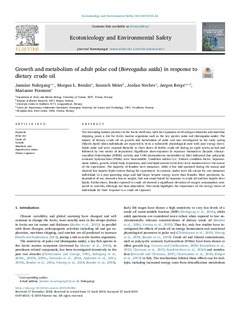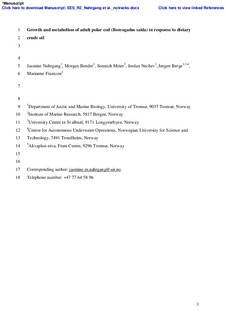| dc.contributor.author | Nahrgang, Jasmine | |
| dc.contributor.author | Bender, Morgan Lizabeth | |
| dc.contributor.author | Meier, Sonnich | |
| dc.contributor.author | Nechev, Jordan | |
| dc.contributor.author | Berge, Jørgen | |
| dc.contributor.author | Frantzen, marianne | |
| dc.date.accessioned | 2020-01-10T09:14:29Z | |
| dc.date.available | 2020-01-10T09:14:29Z | |
| dc.date.created | 2019-05-17T12:25:53Z | |
| dc.date.issued | 2019 | |
| dc.identifier.citation | Ecotoxicology and Environmental Safety. 2019, 180 53-62. | nb_NO |
| dc.identifier.issn | 0147-6513 | |
| dc.identifier.uri | http://hdl.handle.net/11250/2635623 | |
| dc.description.abstract | The increasing human presence in the Arctic shelf seas, with the expansion of oil and gas industries and maritime shipping, poses a risk for Arctic marine organisms such as the key species polar cod (Boreogadus saida). The impact of dietary crude oil on growth and metabolism of polar cod was investigated in the early spring (March–April) when individuals are expected to be in a vulnerable physiological state with poor energy stores. Adult polar cod were exposed dietarily to three doses of Kobbe crude oil during an eight weeks period and followed by two weeks of depuration. Significant dose-responses in exposure biomarkers (hepatic ethoxyresorufine-O-deethylase [EROD] activity and 1-OH phenanthrene metabolites in bile) indicated that polycyclic aromatic hydrocarbons (PAHs) were bioavailable. Condition indices (i.e. Fulton's condition factor, hepatosomatic index), growth, whole body respiration, and total lipid content in the liver were monitored over the course of the experiment. The majority of females were immature, while a few had spawned during the season and showed low hepatic lipid content during the experiment. In contrast, males were all, except for one immature individual, in a post-spawning stage and had larger hepatic energy stores than females. Most specimens, independent of sex, showed a loss in weight, that was exacerbated by exposure to crude oil and low hepatic liver lipids. Furthermore, females exposed to crude oil showed a significant elevation of oxygen consumption compared to controls, although not dose-dependent. This study highlights the importance of the energy status of individuals for their response to a crude oil exposure. | nb_NO |
| dc.language.iso | eng | nb_NO |
| dc.title | Growth and metabolism of adult polar cod (Boreogadus saida) in response to dietary crude oil | nb_NO |
| dc.type | Journal article | nb_NO |
| dc.type | Peer reviewed | nb_NO |
| dc.description.version | publishedVersion | nb_NO |
| dc.source.pagenumber | 53-62 | nb_NO |
| dc.source.volume | 180 | nb_NO |
| dc.source.journal | Ecotoxicology and Environmental Safety | nb_NO |
| dc.identifier.doi | 10.1016/j.ecoenv.2019.04.082 | |
| dc.identifier.cristin | 1698471 | |
| dc.relation.project | Norges forskningsråd: 214184 | nb_NO |
| dc.relation.project | Framsenteret: flagship Hazardous substances 2012 | nb_NO |
| dc.relation.project | Framsenteret: FLAGSHIP HAZARDOUS SUBSTANCES 2012 | nb_NO |
| cristin.unitcode | 7431,18,0,0 | |
| cristin.unitname | Miljøkjemi | |
| cristin.ispublished | true | |
| cristin.fulltext | original | |
| cristin.qualitycode | 1 | |

